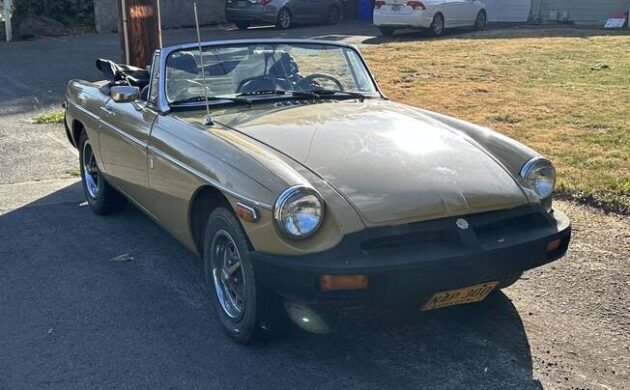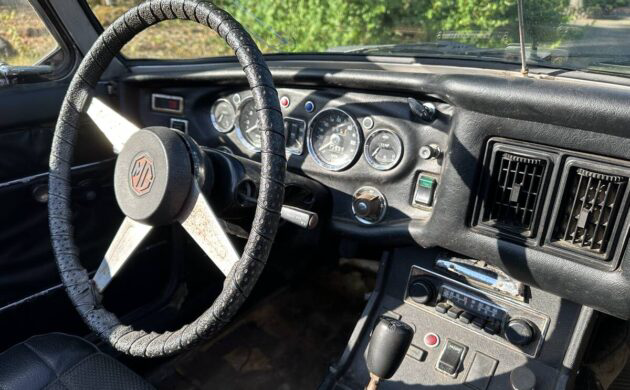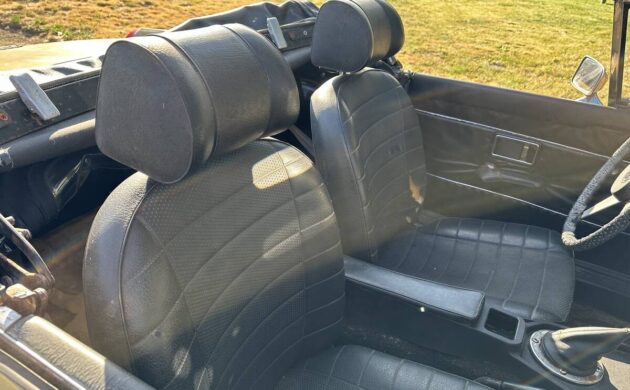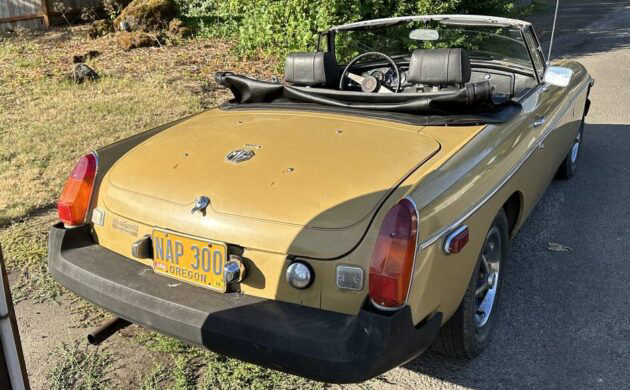Finding a project candidate that is solid, affordable, and promises to be a straightforward restoration can be challenging, but that appears to be the opportunity awaiting the new owner of this 1974 MGB. The seller’s grandfather has been tinkering away on it for years, but the time has come for it to find a new home and an enthusiast willing and able to see the project through to fruition. It appears only to have minor panel, paint, and mechanical needs, and the listing suggests most of these could be tackled in a home workshop. The MG is listed here on Craigslist in Gladstone, Oregon. It could be yours for $3,500 OBO, making it one of the most affordable driving projects in the current market.
This MG is a mystery machine because the paint shade doesn’t seem to gel with anything on the 1974 color palette. It looks strikingly similar to a color called Snapdragon, but it was a one-year-only shade in 1980. The car may have undergone a color change, or it could be a trick of the light. The seller admits the panels and paint have imperfections, and a cosmetic refresh is on the cards. The bumps and bruises are minor, and none would justify steel replacement as part of the restoration process. There is also no apparent rust, meaning returning this gem to its former glory should not be difficult or expensive. The Black soft-top is presentable, although a couple of small tears may motivate the new owner to splash $460 on a replacement. The wheels require restoration, while items like the bumpers might respond positively to a spray-on restoration/protectant product.
The MG’s interior is presentable for those seeking immediate enjoyment, and the only visible addition is the wheel wrap. The dash and console are in good order for their age, but the tired upholstered surfaces and carpet may prompt a retrim. The process will leave no change from $2,500, but the result would be worth the effort and expense. The MGB offers a bare-bones driving experience, although the factory AM/FM radio will relieve boredom on long journeys.
The seller supplies no engine photos, but if this MG is mechanically original, its engine bay should house a 1,799cc four that sends 78hp to the rear wheels via a four-speed manual transmission. That figure is modest, but the natural home of these classics was never the drag strip. The low center of gravity and low curb weight make them ideal to throw into a length of twisting road. The seller indicates the car runs and drives well, but the brakes are suspect. They will stop the car, but it seems they aren’t particularly effective. We can only speculate upon the issue, but the simple engineering of these classics and the ready availability of parts should make rectifying the problem relatively inexpensive.
Okay, we’ve now reached the point where we need to assess the relative worth of this 1974 MGB as a restoration candidate. The purchase price of $3,500 is affordable, and whipping the panels and paint into shape shouldn’t cost a fortune if the new owner is hands-on and there are no hidden rust problems. I would advise an in-person inspection as confirmation, but the indications are positive. Addressing the shortcomings with its interior and top will add around $3,000 to the build. Therefore, this car could look pretty smart for a total investment of under $10,000. Considering you will struggle to find a clean example in the market today below $15,000, that has to make this British sports car worth more than a passing glance.







Looks like it was driven thru a falling rock zone……while the rocks were falling.
With those bumpers, it clearly is not a 1974, that style started for the 1975 model year.. The color looks like the 1972-1976 color, Harvest Gold. It most likely is a 1975 model that was built in 1974.
Some late 1974 B’s came with the rubber bumpers.
I recently purchased a 1977 MGB with rubber bumpers, I think the rubber bumpers were a 1977- 1980 vintage, 1974 came with chrome bumpers
Early ’74 had the chrome bumpers and overriders with small rubber inserts. Mid ’74 had chrome bumpers with the big “Sabrina” rubber bumper blocks. Late ’74 is when this style of bumper came out. That had to be a problematic year for dealers.
Looks like a good car for a good price. If I bought this car the bumpers would disappear on the way home. Also, you don’t want to get frisky on corners until you pull the elevated suspension and replace it. Balance of the car is not good that high and the long springs are way too soft. Parts available to fix all that and should make it a fun car again.
I would tend to agree about ditching the Rubber Baby Bumpers. However, it is not just a simple matter of bolting on a set of the earlier chrome bumpers, There is a kit for sale, which involves cutting and welding to accept the chrome
bumpers.
Bob, I’m smiling as I picture just exactly how those bumpers might disappear on the way home.
Got a landfill just off the highway that gets us back to town.
There is a lot of mis-information floating around about the model changes in 74-75-76 B’s with rubber bumpers. As Landers says, the rubber bumpers were late in the 74 model year, and the rubber bumper cars were limited to the last few months of the production run. They had the tall ride height and federally mandated bumpers, but non-assisted brakes and dual HIF SU carburettors.
Because they were not as warmly received as the earlier models, they have become relatively cheap on the market, and a great entry level collector/project car. The problem is that folks that don’t know about the marque hear and see the wrong info and after a while that becomes what folks believe. It has been common in the past for folks to lower the ride height, refit to earlier distributor/carburettors/exhaust system and add an overdrive gearbox to create a very good cruiser/driver level car. IMO, the later rubber bumper cars look great with the lower ride height, and while you can’t get over 90 horsepower without major engine mods, the improved induction/exhaust systems make these a very good performing B. I’ve done several.
Rufus X 2. There were no less than three 1974 MGBs: the first being identical to the 1973s, the second retaining the chrome bumpers but with the addition of the “Sabrinas” – huge rubber bumper guards, and then at midyear, the rubber-bumpered “74 and a half” cars. ‘75s were almost the same except gone were the twin SU carbs in favor of the single Zenith-Stromberg carb. North America never saw new B/GTs after 1974. The dashboard design implemented in 1972 remained through 1976. 1977-1980 models look like the earlier rubber-bumpered cars on the exterior, but a new dashboard design was implemented. There were other changes that I cannot recall in order, but the 1980 models had not one but two carbon canisters. By this time, the engine that once had 96 hp (1967) was smothered down to 60-some hp. They were VERY smooth-running compared to earlier cars. And one actual improvement they did make – I believe in 1977 – was to add a rear anti-sway bar.
I had a ’76 model – purchased with the engine torn down due to a spun bearing. I rebuilt the engine to 1967 specs, with SU carbs and an improved exhaust. It ran very well and I drove it 66,000 miles over 11 years.
Just an observation…… Looking close I’m pretty sure the dash has one of those hard pre-formed covers glued on to hide the cracked & peeling original dash material.
that whole padded dash can be replaced, or just the top section. The top section, IMHO, isn’t going to fool anyone, but it’s inexpensive and relatively easy to do. The whole padded dash can be replaced, and is a big job. All gauges, controls, etc have to come out . . . and back in. The part itself is $$$. Moss Motors has them, for each of the different year changes.
If I can be pardoned a minor quibble with MGSteve, I believe that carefully installed “Coverlays” can look quite convincing, but to be completely honest, perhaps that may be due to my having lower standards. I do know that on cars I suspect of having Coverlays, I’ve often had to inspect very closely to confirm my suspicion. Certainly they cannot improve on defects they don’t cover. I believe MGSteve will agree with me that a Coverlay looks better than the black eletrician’s tape we see so often!
My wife wanted one of these back around 1980. Went to look at one, with my size 13 feet I couldn’t drive it! Every time I mashed the clutch, I mashed the brake with the same foot! Needless to say, that ended any ideas of owning a MGB!